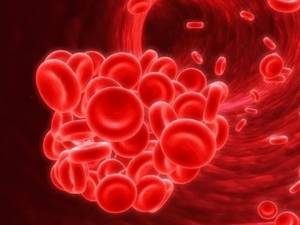When is a hemostasiogram (coagulogram) prescribed?
Indications for this analysis are:
- Heavy and prolonged bleeding;
- Miscarriages, unsuccessful IVF attempts;
- Varicose veins, thrombosis;
- Heart disorders;
- Pre-infarction condition;
- Heart attacks, strokes;
- Presence of blood in urine and stool;
- Liver disorders;
- Taking anticoagulants, corticosteroids, oral contraceptives.
A blood clotting test is carried out before operations of any complexity and during pregnancy to exclude the possibility of uncontrolled bleeding or thrombus formation during surgery or during childbirth.
Preparation for a hemostasiogram
Blood is drawn from a vein on an empty stomach - that is, the patient’s last meal should be 8-12 hours before the procedure. In the morning before the analysis, you can drink some pure still water. On the eve of the test, you should avoid stress, physical and mental fatigue, and do not drink alcohol. Do not smoke for at least 2 hours before taking blood.
Biomaterial should not be submitted for analysis earlier than 3-5 days after ultrasound, x-rays or physical procedures.
If it is necessary to monitor indicators over time, subsequent studies should be carried out under identical conditions: in the same laboratory, at the same time of day, etc.
Important! A few days before the test, you need to stop taking medications, especially those that affect clotting (for example, aspirin). If the patient takes such drugs on a regular basis, it is necessary to discuss this issue with the attending physician!
It is not advisable for women to undergo screening during menstruation - real data on hemostasis during this period may be distorted.
Mechanism of hemostasis
When blood vessels are damaged, a cascade chain of reactions in the body is triggered:
- First, a narrowing of blood vessels occurs to allow blood to flow away from the damaged area.
- Platelets rush to the injured area and form a parietal thrombus, which acts as a “patch” at the site of damage.
- Thromboplastin activates prothrombin, from which active thrombin is formed. And thrombin, in turn, promotes the conversion of blood plasma protein – fibrinogen, into fibrin.
- Fibrin has a thread-like structure, and with the help of these threads the body forms a mesh into which blood cells - platelets, red blood cells and white blood cells - rush, forming a clot.
- The clot hardens over time, forming a blood clot that reliably protects the damaged area.
- As the tissue heals, the clot dissolves. This process is called fibrinolysis.
Conventionally, external and internal pathways of hemostasis activation are distinguished, depending on the triggering mechanisms.
Content
- Hemostasiogram. Where to get tested
- Hemostasiogram. How to take it
- Cost of analysis
Research confirms the enormous importance of coagulation system parameters in the treatment of almost all human diseases.
The state of the blood coagulation system is especially important in the treatment of cardiovascular, surgical, oncological, neurological diseases, and during pregnancy. For emergency conditions such as heart attack or stroke, as well as in preparation for surgical interventions, this type of analysis is of great importance.
In the human body, most processes are in a balanced state. This balance is the key to health. Blood clotting is a protective mechanism that prevents fatal blood loss.
However, an imbalance and a shift towards a pathological state, hypercoagulation, can lead to the formation of blood clots in the lumen of an undamaged vessel. Thrombosis poses a threat to the health and life of the patient, since when vital arteries are blocked, blood supply to the heart, brain, lungs and other organs is impaired.
Every year hundreds of thousands of people die from heart attacks and strokes, and many more remain disabled. It has been proven that monitoring the coagulation system in patients with cardiovascular pathologies improves the prognosis by more than 50% and reduces the risk of sudden death.
A special analysis, hemostasiogram, allows you to find out about disorders in the blood coagulation system and correct them. Hemostasiogram (coagulogram) is a comprehensive analysis of the blood coagulation system. What do patients referred for this test need to know?
A hemostasiogram or coagulogram is mainly of two types - basic and extended. A basic coagulogram includes:
- number of platelets, red blood cells, hemoglobin, hematocrit;
- fibrinogen;
- prothrombin;
- INR;
- prothrombin time (PT);
- APTT (activated partial thromboplastin time);
- prothrombin index (PI);
- thrombin time;
- RFMC (soluble fibrin-monomer complexes).
An expanded or expanded hemostasiogram includes some additions: lupus anticoagulant, D-dimer, antithrombin III. A detailed hemostasiogram is often prescribed to patients with obvious pathology of the coagulation system and pregnant women.
Laboratory parameters of hemostasis
To diagnose blood clotting, the following studies are performed:
- Time to stop bleeding. The time period from the onset of bleeding until it stops.
- Prothrombin time (PTT). To determine it, special reagents are added to the plasma. The time at which the plasma under study coagulates is called the PTT.
- Prothrombin index (PTI). The ratio of the prothrombin time of the analyzed plasma and the same indicator of the reference plasma, expressed as a percentage.
- Prothrombin according to Quick (PC). The result of the analysis indicates the content of coagulation factors in the blood, expressed as a percentage. Evaluates the extrinsic coagulation mechanism.
- INR (international normalized ratio). The result of comparing the clotting time of the analyzed plasma with plasma normalized according to the international protocol. Analysis with a high degree of reliability and standardization.
- Activated partial thromboplastin time (aPTT). The time it takes for a clot to form when special reagents are added to the blood being tested. The assay measures the efficiency of the intrinsic clotting pathway.
- Plasma recalcification time (PRT). Indicates the general activity of the coagulation process. In the laboratory, the clotting time of the analyzed blood and blood saturated with calcium ions is compared.
- Fibrinogen. A blood plasma protein produced by the liver. Under the influence of thrombin, it turns into fibrin - a building material for a platelet clot.
- Thrombin time. The time required for the conversion of fibrinogen to fibrin.
- Soluble fibrin-monomeric complexes RKFM. Occurs when fibrin breaks down. Diagnosis of both the coagulation system and fibrinolysis.
- Antithrombin III is a protein substance produced by the liver. It has a pronounced anticoagulant property.

An increase in prothrombin time, a decrease in PI, an increase in PC and INR indicate hypocoagulation, which is fraught with bleeding. May indicate liver dysfunction, vitamin K deficiency, or taking anticoagulants.
A shortening of prothrombin time, an increase in PI, and a fall in PC and INR indicate an increase in coagulation and the threat of vascular blockage. May occur during pregnancy and after childbirth.
A coagulogram and a hemostasiogram differ in their set of indicators. Hemostasiogram is a more extensive study that includes coagulogram data and a number of other indicators. The doctor decides what kind of analysis you need based on the diagnostic purposes.
Coagulogram, expanded
Coagulogram, extended - a set of indicators of the blood coagulation system, recommended during pregnancy, recurrent miscarriage and for patients with a high risk of developing complications from the hemostatic system (blood coagulation). Normally, the body constantly maintains a balance of blood coagulation and anticoagulation systems. Pregnancy is a period when multiple restructuring of the hemostatic system occurs, because blood flow in the placenta is formed, hormonal levels change and the body strengthens coagulation factors (physiological hypercoagulation) to avoid the consequences of bleeding during childbirth.
What is included in the complex?
Mandatory screening indicators:
- APTT
- Prothrombin (time, according to Quick, INR)
- Thrombin time
- Fibrinogen
Antithrombin III is a natural anticoagulant; its decrease is one of the reasons for recurrent miscarriage and fetal death.
D-dimer is a marker of fibrin breakdown (fibrinolysis. Used to monitor pregnant women over time.
Lupus anticoagulant, screening - used to diagnose antiphospholipid syndrome, the onset of which is often observed during pregnancy, causing miscarriage and other complications.
In what cases is the Coagulogram complex, expanded, prescribed?
- In case of a normal pregnancy and the absence of risk factors, once, then according to the decision of the attending physician.
- In case of complicated pregnancy and/or the presence of risk factors - repeatedly, monitoring over time (decided by the attending physician)
- Patients with miscarriage
- Dynamic observation and assessment of the effectiveness of therapy in patients with cardiovascular diseases and the risk of developing thrombosis
What do the test results mean?
The result reflects the parameters of the hemostatic system at the time of the study, so influencing factors should be taken into account and monitored over time if there are deviations.
The interpretation is carried out by a qualified doctor, taking into account data from the anamnesis, examination and other research methods.
Test deadlines.
Extended coagulogram is prepared within 1-2 days
How to prepare for the analysis?
Blood is donated strictly in the morning, on an empty stomach (at least 8 hours of fasting) while observing the drinking regime. It is necessary to indicate the anticoagulants taken by the patient, NSAIDs (non-steroidal anti-inflammatory drugs - paracetamol, aspirin, Nurofen, diclofenac, etc.), oral contraceptives, antibiotics. No special preparation is needed.
Studies of the hemostasis system
The hemostasis system is the interaction of the coagulation and anticoagulation systems of the blood. Disturbances in the hemostatic system lead to dangerous consequences: increased blood clotting leads to the formation of blood clots (so-called thrombophilia), which cause heart attacks, strokes, miscarriage and other dangerous conditions. A decrease in the activity of the process causes bleeding.
THE HEMOSTASIS LABORATORY OF THE BLOOD CLINIC PERFORMS ALMOST ALL HEMOSTASIS STUDIES:
- Thrombodynamics (innovative analysis to assess the total activity of the entire hemostatic system)
- Complete blood count with determination of platelet count, clotting time and bleeding duration (standard preoperative examination)
- Aggregatogram - study of platelet activity (performed with 4 inducers: ADP, adrenaline, collagen, ristomycin)
- Von Willebrand factor activity – to clarify the causes of bleeding
- Coagulation factors VIII and IX – to exclude hemophilia
- Complex studies of hemostasis in the laboratory of the Blood Clinic
COMPLEX 1 Approximate hemostasiogram:
APTT, prothrombin time, thrombin time, IPT, INR, fibrinogen, induced platelet aggregation screening with 2 inducers (ADP, adrenaline)
COMPLEX 7 Thrombogenic readiness syndrome (extended study of hemostasis):
APTT, PTI, INR, PT, fibrinogen, TV, CPP, plasminogen, antithrombin III, protein C activity, induced platelet aggregation screening with 2 inducers (ADP, adrenaline), D-dimer, f activity. coagulations VIII and IX
COMPLEX 8
Extended study of hemostasis:
Lupus anticoagulant (screening), APTT, PTI, INR, PT, fibrinogen, CZP, TV, D-dimer, plasminogen, antithrombin III, protein C activity, induced platelet aggregation screening with 2 inducers (ADP, adrenaline), f activity. coagulations VIII and IX
COMPLEX 9 Coagulogram “Thrombogenic readiness syndrome”:
APTT, PTI, INR, PT, fibrinogen, TV, CHF, plasminogen, antithrombin III, protein C activity, D-dimer, f activity. coagulations VIII and IX
COMPLEX 10 Coagulogram:
Lupus anticoagulant (screening), APTT, PTI, INR, PT, fibrinogen, CHF, TV, D-dimer, plasminogen, antithrombin III, protein C activity, f activity. coagulations VIII and IX
ATTENTION! Even a comprehensive study of hemostasis does not always allow one to assess the risk of developing blood coagulation disorders and prescribe effective treatment. To make the diagnosis as accurate as possible, a study is carried out of the genes that “program” the response of the blood coagulation system to various provoking factors (inflammation, pregnancy, etc.). If necessary, in our clinic you can take such an analysis to identify polymorphisms (mutations) of hemostasis genes.
IMPORTANT TO REMEMBER! Only a doctor can correctly interpret the results of a hemostasis study and prescribe treatment. However, there are not many hemostasiologists in medical institutions in Novosibirsk. Experienced hematologists and hemostasiologists provide consultations at the Blood Clinic. You can make an appointment on the day of the test, by phone, or through an application on the website!
Blood collection for hemostasis analysis at the Blood Clinic from Monday to Friday from 07:30 to 11:00, or on Saturday from 9:00 to 11:00 (on an empty stomach, without an appointment).
PRE-REGISTRATION FOR THROMBODYNAMICS TEST ONLY!
HOW TO CORRECTLY PREPARE FOR BLOOD Collecting FOR HEMOSTASIS AND THROMBODYNAMICS TEST




